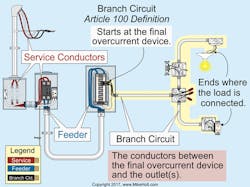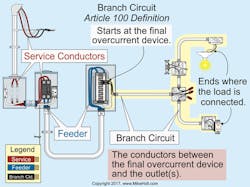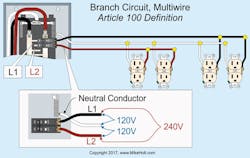Understanding the branch-circuit requirements in Art. 210 is critical to completing Code-compliant installations. Article 100 defines a “branch circuit” as the conductors between the final overcurrent protective device (OCPD) and the receptacle outlets, lighting outlets, or other outlets (Fig. 1). The general requirements for branch circuits are in Art. 210, but Chapters 5, 6, and 7 contain requirements for many types of specific equipment and applications. Even more requirements are included in Chapter 4 (see Table 210.3).
Typically, a branch circuit is “multiwire.” But what does this mean? A multiwire branch circuit consists of two or more ungrounded circuit conductors with a common neutral conductor. There must be a difference of voltage between the ungrounded conductors and an equal difference of voltage from each ungrounded conductor to the common neutral conductor (Fig. 2). The circuit must supply only line-to-neutral loads [201.4(C)].
A multiwire branch circuit can be considered a single circuit or a multiple circuit [210.4(A)]. All conductors of a multiwire branch circuit must originate from the same panelboard (to prevent inductive heating and reduce conductor impedance for fault currents).
Each multiwire branch circuit must have a means to simultaneously disconnect all ungrounded conductors where the branch circuit originates [210.4(B)]. Ungrounded and neutral conductors of a multiple branch circuit must be identified or grouped together by cable ties or similar means in every enclosure [new with the 2017 NEC: This must be done per Sec. 200.4(B)].
Identification
The neutral in these circuits is grounded. The neutral identification requirements are outlined in Art. 200. You’ll find a list of eight methods for identifying neutrals sized 6 AWG or smaller [200.6(A)] and four methods for neutrals sized 4 AWG or larger [200.6(B)].
Equipment grounding conductors can be bare, covered, or insulated. Insulated equipment grounding conductors size 6 AWG and smaller must have a continuous outer finish either green or green with one or more yellow stripes [250.119]. On equipment grounding conductors 4 AWG and larger, insulation can be permanently re-identified with green marking at the time of installation at every point where the conductor is accessible [250.119(A)].
It’s common for premises wiring systems to have more than one nominal voltage system with branch circuits. Where that situation exists, each ungrounded conductor must be identified by phase and system at all termination, connection, and splice points [210.5(C)(1)].
You can identify the conductors using color coding, marking tape, tagging, or other means approved by the authority having jurisdiction (AHJ). But the method of identification must be readily available or permanently posted at each branch-circuit panelboard. This can’t be handwritten. It must be of sufficient durability to withstand its environment (Fig. 3).
Where a different voltage system is added to an existing installation, branch-circuit identification is required for the new voltage system. Existing unidentified systems don’t have to be identified at each termination, connection, and splice point. Each voltage system distribution equipment must have a label with the words “other unidentified systems exist on the premises.”
GFCI
Provide ground-fault circuit interruption (GFCI) as required in Sec. 210.8(A) through (E) (the 2017 NEC added requirements). Install the GFCI device in a readily-accessible location.
Among the places where GFCI protection is required for 15A and 20A, 125V receptacles in dwelling units:
• In garages and in grade-level portions of accessory buildings used for storage or work areas of a dwelling unit [210.8(A)(2)].
• Where they serve countertop surfaces [210.8(A)(6)].
• If they are within 6 ft from the top inside edge of the bowl of a sink [210.8(A)(7)] (the 2017 NEC revised this requirement).
The 2017 NEC retains the two new locations added with the 2014 NEC:
1. Within 6 ft of the outside edge of a bathtub or shower stall [210.8(A)(9)].
2. In laundry areas [210.8(A)(10)].
Among the 10 places where GFCI protection is required for 15A and 20A, 125V receptacles in other than dwelling units, two are new with the 2017 NEC:
• Crawl spaces [210.8(B)(9)].
• Unfinished portions of basements [210.8(B)(10)].
How many?
The Code does not limit the number of receptacles on a circuit in a dwelling unit. Theoretically, you could install a receptacle on every other stud (many homeowners would like that) all on one circuit. But there is a practical limit, and common sense comes into play.
You determine the minimum number of general lighting and general-use receptacle branch circuits by dividing the total calculated load in amperes by the ampere rating of the circuits used [210.11(A)].
If you calculate the load on the volt-amperes/square foot, you must provide the wiring system to serve the calculated load. The loads must be evenly proportioned among multioutlet branch circuits within the panelboard [210.11(B)]. Also, at least:
• Two 20A, 120V small-appliance receptacle branch circuits are required to supply receptacle outlets in a dwelling unit kitchen, dining room, pantry, or similar dining area [210.52(B)]. These can be supplied by one 3-wire multiwire circuit or two separate 120V circuits [210.4(A)]. Lighting outlets or receptacles in dwelling unit areas cannot be connected to the small-appliance branch circuit [210.52(B)(2)].
• One 20A, 120V branch circuit is required to supply receptacle outlet(s) in the laundry area [210.52(F)]. This circuit cannot serve any other outlets (e.g., laundry room lighting). GFCI protection is required for 15A and 20A, 125V receptacles in a laundry room [210.8(A)(10)].
• One 20A, 120V branch circuit is required to supply the bathroom(s) receptacle outlet(s) [210.52(D). This circuit cannot serve any other outlet (e.g., bathroom lighting outlets).
• One 20A, 120V branch circuit is required to supply the receptacle outlet(s) in attached garages and detached garages with electric power [210.52(G)]. This 20A, 120V branch circuit cannot serve any other outlet. This requirement is new with the 2017 NEC.
AFCI
Arc-fault circuit-interrupter (AFCI) devices must be installed in readily-accessible locations. AFCIs must be provided for 15A or 20A, 120V branch circuits supplying outlets and devices in these locations [210.12(A), (B) and (C)]:
(A) Dwelling units supplying outlets or devices in kitchens, dining rooms, living rooms, parlors, libraries, bedrooms, sunrooms, recreation rooms, closets, hallways, laundry areas, or similar areas.
(B) Dormitory unit bedrooms, living rooms, hallways, closets, bathrooms, and similar rooms.
(C) Guest rooms and guest suites of hotels and motels (this requirement is new with the 2017 NEC).
Rating
Branch circuits must be rated per the maximum permitted ampere rating circuit OCPD [210.18]. The rating for circuits that are not individual branch circuits must be 15A, 20A, 30A, 40A, and 50A. If higher ampacity conductors are used, the ampere rating of the circuit’s OCPD determines the circuit ampere rating.
Exception: Multioutlet branch circuits greater than 50A can supply nonlighting outlet loads on industrial premises where conditions of maintenance and supervision ensure only qualified persons service the equipment.
Sizing
Branch-circuit conductors must have an ampacity of at least the maximum load to be served. The conductor must be sized the larger of (a) or (b).
(a) At least 125% of the continuous loads, plus 100% of the noncontinuous loads, based on the terminal temperature rating ampacities as listed in Table 310.15(B)(16).
(b) The maximum load to be served after the application of any adjustment or correction factors.
Exception No. 1: If the assembly and the OCPD are both listed for operation at 100% of its rating (rare below 400A), the conductors can be sized at 100% of the continuous load.
Branch circuits that supply more than one receptacle must have an ampacity at least the rating of the circuit OCPD [210.18].
Branch-circuit conductors that supply household ranges, wall-mounted ovens or counter-mounted cooking units must have an ampacity not less than the rating of the branch circuit — and not less than the maximum load to be served. For ranges of 8¾kW or more rating, the minimum branch-circuit ampere rating is 40A. See Exceptions under Sec. 210.19(A)(3).
Overcurrent protection
Each branch-circuit OCPD must have a rating of at least 125% of the continuous loads, plus 100% of the noncontinuous loads [210.20(A)]. If the assembly and OCPD are both listed for operation at 100% of their rating (rare below 400A) you can size the branch-circuit OCPD at 100% of the continuous load. Protect the conductors per Sec. 240.4 and the equipment per Sec. 240.3.
Wrap up
That’s a lot to try to remember about branch-circuit requirements. Always methodically review your design against Art. 210, Parts I and II. Next month, we’ll look at how certain types of loads add even more requirements.
These materials are provided to us by Mike Holt Enterprises in Leesburg, Fla. To view Code training materials offered by this company, visit www.mikeholt.com/code
About the Author

Mike Holt
Mike Holt is the owner of Mike Holt Enterprises (www.MikeHolt.com), one of the largest electrical publishers in the United States. He earned a master's degree in the Business Administration Program (MBA) from the University of Miami. He earned his reputation as a National Electrical Code (NEC) expert by working his way up through the electrical trade. Formally a construction editor for two different trade publications, Mike started his career as an apprentice electrician and eventually became a master electrician, an electrical inspector, a contractor, and an educator. Mike has taught more than 1,000 classes on 30 different electrical-related subjects — ranging from alarm installations to exam preparation and voltage drop calculations. He continues to produce seminars, videos, books, and online training for the trade as well as contribute monthly Code content to EC&M magazine.




